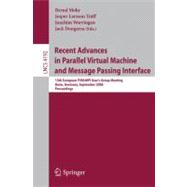
| Too big for MPI? | p. 1 |
| Approaches for parallel applications fault tolerance | p. 2 |
| Where does MPI need to grow? | p. 3 |
| Peta-scale supercomputer project in Japan and challenges to life and human simulation in Japan | p. 4 |
| Resource and application adaptivity in message passing systems | p. 5 |
| Performance advantages of partitioned global address space languages | p. 6 |
| Using MPI-2 : a problem-based approach | p. 7 |
| Performance tools for parallel programming | p. 8 |
| High-performance parallel I/O | p. 10 |
| Hybrid MPI and OpenMP parallel programming | p. 11 |
| Issues in developing a thread-safe MPI implementation | p. 12 |
| Scalable parallel suffix array construction | p. 22 |
| Formal verification of programs that use MPI one-sided communication | p. 30 |
| MPI collective algorithm selection and quadtree encoding | p. 40 |
| Parallel prefix (scan) algorithms for MPI | p. 49 |
| Efficient Allgather for regular SMP-clusters | p. 58 |
| Efficient shared memory and RDMA based design for MPIöAllagather over InfiniBand | p. 66 |
| High performance RDMA protocols in HPC | p. 76 |
| Implementation and shared-memory evaluation of MPICH2 over the nemesis communication subsystem | p. 86 |
| MPI/CTP : a reconfigurable MPI for HPC applications | p. 96 |
| Correctness checking of MPI one-sided communication using Marmot | p. 105 |
| An interface to support the identification of dynamic MPI 2 processes for scalable parallel debugging | p. 115 |
| Modeling and verification of MPI based distributed software | p. 123 |
| FT-MPI, fault-tolerant metacomputing and generic name services : a case study | p. 133 |
| Scalable fault tolerant protocol for parallel runtime environments | p. 141 |
| An intelligent management of fault tolerance in cluster using RADICMPI | p. 150 |
| Extended mpiJava for distributed checkpointing and recovery | p. 158 |
| Running PVM applications on multidomain clusters | p. 166 |
| Reliable orchestration of distributed MPI-applications in a UNICORE-based grid with MetaMPICH and MetaScheduling | p. 174 |
| The new multidevice architecture of MetaMPICH in the context of other approaches to grid-enabled MPI | p. 184 |
| Using an enterprise grid for execution of MPI parallel applications - a case study | p. 194 |
| Self-adaptive hints for collective I/O | p. 202 |
| Exploiting shared memory to improve parallel I/O performance | p. 212 |
| High-bandwidth remote parallel I/O with the distributed memory filesystem MEMFS | p. 222 |
| Effective seamless remote MPI-I/O operations with derived data types using PVFS2 | p. 230 |
| Automatic memory optimizations for improving MPI derived datatype performance | p. 238 |
| Improving the dynamic creation of processes in MPI-2 | p. 247 |
| Non-blocking Java communications support on clusters | p. 256 |
| Modernizing the C++ interface to MPI | p. 266 |
| Can MPI be used for persistent parallel services? | p. 275 |
| Observations on MPI-2 support for hybrid master/slave applications in dynamic and heterogeneous environments | p. 285 |
| What MPI could (and cannot) do for mesh-partitioning on non-homogeneous networks | p. 293 |
| Scalable parallel trace-based performance analysis | p. 303 |
| TAUg : runtime global performance data access using MPI | p. 313 |
| Tracing the MPI-IO calls' disk accesses | p. 322 |
| Measuring MPI send and receive overhead and application availability in high performance network interfaces | p. 331 |
| Challenges and issues in benchamarking MPI | p. 339 |
| Implementation and usage of the PERUSE-interface in open MPI | p. 347 |
| Current trends in numerical simulation for parallel engineering environments | p. 356 |
| MPJ express meets gadget : towards a Java code for cosmological simulations | p. 358 |
| An approach for parallel fluid-structure interaction on unstructured meshes | p. 366 |
| Optimizing a conjugate gradient solver with non-blocking collective operations | p. 374 |
| Parallel DSMC gasflow simulation of an in-line coater for reactive sputtering | p. 383 |
| Parallel simulation of T-M processes in underground repository of spent nuclear fuel | p. 391 |
| On the usability of high-level parallel IO in unstructured grid simulations | p. 400 |
| Automated performance comparison | p. 402 |
| Improved GROMACS scaling on ethernet switched clusters | p. 404 |
| Asynchronity in collective operation implementation | p. 406 |
| PARUS : a parallel programming framework for heterogeneous multiprocessor systems | p. 408 |
| Application of PVM to protein homology search | p. 410 |
| Table of Contents provided by Blackwell. All Rights Reserved. |
The New copy of this book will include any supplemental materials advertised. Please check the title of the book to determine if it should include any access cards, study guides, lab manuals, CDs, etc.
The Used, Rental and eBook copies of this book are not guaranteed to include any supplemental materials. Typically, only the book itself is included. This is true even if the title states it includes any access cards, study guides, lab manuals, CDs, etc.